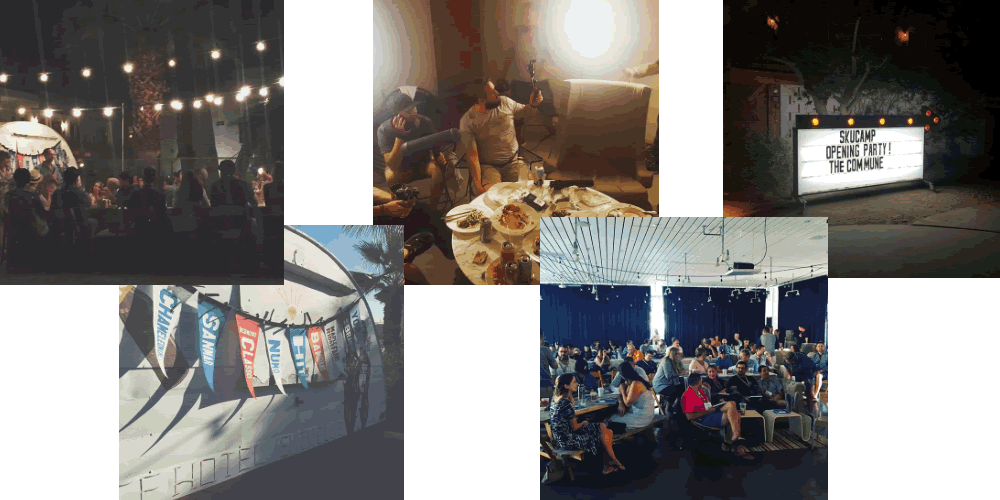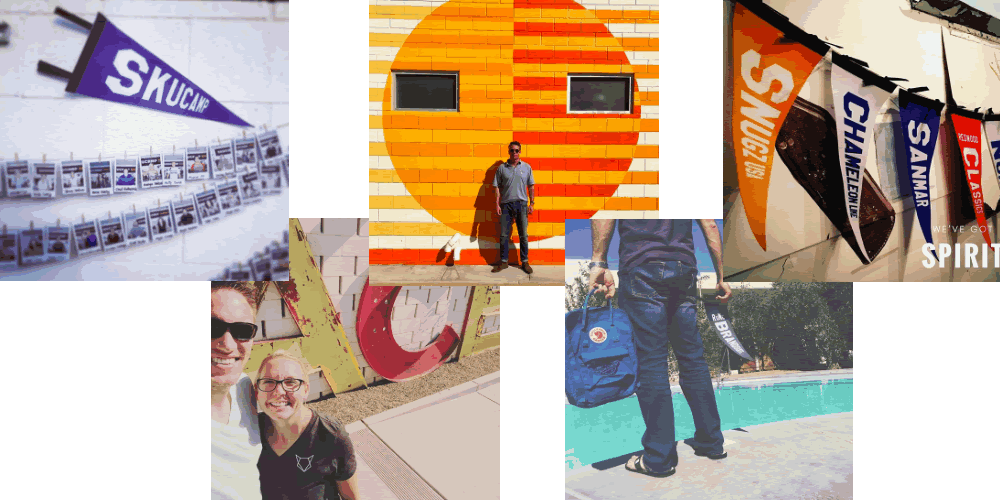skucamp "Starter Steps" to Making Big Changes
Headed home from #skucamp super bummed it’s actually over. It was an amazing event with so much #love poured into it. Thank you @commonsku
— Ben Taylor (@bentayloractual) October 4, 2017
We just wrapped our inaugural skucamp and words can hardly express how proud we are to play a small part in inspiring and igniting creative entrepreneurs in this profession. Over the past few days, the atmosphere crackled with so many ideas that it’s hard to focus on where to start, but we thought we would suggest just a few starter steps to launch the next biggest season of your growth! (The following post is written as a follow-up piece to our pre-skucamp post, 10 Tips To Help You Ace 2018).
Denise Taschereau / Building a Purpose Driven Brand
Denise Taschereau’s session about Building a Purpose Driven Brand was a powerful example of how to build a brand on purpose, with purpose, and how to shift your brand toward a much larger vision. One powerful step toward reimagining your brand is a simple pivot. Many of us see an inspiring brand like Fairware or Anthem Branding, and we forget that their transformation was part revolution but also part evolution. If you are trying to shift your brand and your image, instead of getting overwhelmed by a sudden wholesale change, even a simple pivot toward the right direction can, over time, transform your company. “So how do you start?” asks Denise. “It’s actually simple. Take stock. Look at the good stuff you’re doing and articulate it, write it down, talk about it with staff. Share it. Publicly. Set goals.” Most of the revolutionary businesses we respect were built using simple pivots over the course of time. But here’s a few steps that might help you pivot:
What was the initial spark of inspiration that led you into business in the first place (what problem were you passionate about solving)?
Call three clients this week and ask them why they do business with you. Challenge them to give answers beyond your great price and service.
Write down the names of 3 industry companies you admire from afar. What 3-5 traits do you admire about them? Why?
Denise’s presentation in PDF format.
Matty Toomb / Master the Art of Selling
Matty Toomb, shared a ton of tips in his action-packed presentation, including obsessive follow up and requesting a virtual from suppliers every day. He also shared this incredible anecdote about Coach Wooden. When Wooden’s team jogged to the sideline during a timeout, the coach said to his center “you’re getting no rebounds,” and to his forward “you’re getting beat up and down the court” and to his guard, “you made no shots.” One of his players replied, “But Coach, we are winning 57-21,” to which the venerable coach replied, “I know nothing about that. I am speaking about your performance compared to your potential.” Starter steps:
Define your 2018 sales goals by November 1st and ask a friend or trusted advisor to review them with this question: “Do my goals reflect my true potential?” Make this question a cornerstone question with your team as you develop your goals.
List a sales increase goal beside each customer, make a cursory list of the categories you are not selling to each of those clients and map a plan to introduce new products to these customers using the next step.
Identify your top five supplier partners and implement a spec sample program or a virtual request from each of these suppliers for your top 10 clients.
“Realize, January 1 you will lose 20% of your business,” said Matty. With that advice, implement a prospecting plan to reach out to one new prospect a week, beginning now. Be sure to log these opportunities in commonsku and track your progress on each prospect.
Matty’s presentation in PDF format.
Jamie Watson / Create Maximum Financial Value in Your Business
Jamie Watson shared critical key performance indicators like optimum average margins, the percentage of sales your largest customer should comprise (10%), accounts receivable collection period and many more financial health tips. One big step to make sure you are creating maximum value (which Jamie defines as “creating future sustainable earnings,”) is to analyze your customers sales, find out if your number one customer is no more than 10% of your sales and then, begin to work on a plan to diversify. A few other starter steps:
Jamie said that there were three factors that drive earnings up: Good gross margins, proper sales compensation, control of overhead. Identify your most anemic financial figures, is this gross margin? Net profit? Number of clients? Put these figures on your personal dashboard and begin to make small, marginal improvements.
Analyze your current sales commission structure. Does it inspire sales growth? Are there small pivots you can make in your commission structure to drive initiative?
Analyze your profit margin by customer and begin an incremental increase per customer. (See also our post, 8 Secrets the Pros Know About Protecting Your Bottom Line and Maximizing Your Profit).
Jamie’s presentation in PDF format.
Danny Rosin / Make Intimacy a Marketing Strategy
Danny Rosin passionately pushed us to create shared experiences around your brand to get people away from their desks. “Be the brand you want to be. Be bold. Be brave. Host small events for your customers like a Make and Bake or volunteer with them at a not-for-profit.” A few steps:
Look at your company events calendar for the year and begin to populate it with monthly events designed to engage with your customers in creative ways for the sole purpose of getting them away from their busyness so that you can make a human connection. An ambitious suggestion: Create one per quarter (see Danny’s presentation below for more ideas).
Danny said we should “Work toward optimal temporal bias. Humans recall peak emotional experiences more than average ones. If we want people to remember us we must deliver emotional stamps.” Identify your key clients/prospects and assess their business/personal “love languages.” Determine what might surprise and make them feel good about your thoughtfulness. Build a purposeful plan to surprise and delight your customers using the power of our medium to engage. An example: Start a holiday campaign or anniversary campaign with your customers, a deliberate marketing outreach to connect face-to-face.
Danny’s presentation in PDF format.
Bobby Lehew / 7 Enchanting Secrets of Creative Storytelling
Storytelling is a craft that we can all use, whether you are in sales, customer service, or accounting. “Alertness is the key discipline of familiarity,” wrote the poet David Whyte and we should remain vigilant throughout the year to spot the awesome customer stories that our products play an important part in. A few key tips to kick-start better stories for you for 2018:
Determine your top three projects you have done for a client that can become an anchor story that reflects you and your UVP. It might just be one or two stories, but write these from the perspective of the customer and their authentic experience, not from the perspective of the product. Publish these stories on your website, or, at least get them written and share among your team members so that these stories get deposited into your memory bank so you can draw on them when communicating with prospects.
Need help kick starting your story? My session included one of my favorite new tips I learned from Pixar and it’s a very simple tool. After learning that you should never tell a product story (a story from the product’s perspective) and that you should create stories about customers from the client’s perspective and based on their authentic experience, you can simplify the process by filling in these blanks: Once upon a time there was ______. Every day, ______. One day ______. Because of that, ______. Because of that, ______. Until finally ______.
My presentation in PDF format.
Ted Church / Build Authentic Brand Experiences for Lasting Connections
Ted Church brought his signature style and creative mastery to skucamp in the form of many case histories and he shared four goals for building a better swag experience including, inspiring clients to create themed collections for their brands, consistently translating a conceptual theme into unique and stylish products, demonstrating the ability of a merchandise collection to tell a brand story and evangelize an audience, and structuring these around audience personas. “Design is an expression of purpose,” said Ted. A few action steps:
Analyze how you are presenting ideas to your client and begin your own internal makeover program designed to inspire your customers.
Make “theme-based ideation” an important part of your search for client ideas. Always ask: What is the consistent theme for this project?
Begin to invest in photographing the best campaigns you design for clients so that you can build a strong presentation that reflects your creativity and style. Make this a priority next year and, by year end, you will have a fantastic project database to draw on. A suggested goal: Capture one campaign/story per month and by year-end, you’ll have a beautiful dozen stories to share.
Ted’s presentation in PDF format.
Catherine Graham / Business Growth and Scaling Strategies
Catherine Graham spoke about structure, process, and scaling your business for future growth. “You may sacrifice near-term profit for growth as you invest in the business, but this should have a limited time horizon. Beware of sacrificing gross margin for growth – buying low margin business rarely has a good long-term outcome.” A few action steps:
Write out your goals and think 2-5 years out, for example: I want to be a $10MM company by 2022 ; I want to have a $1MM portfolio by 2020; I want my sales territory to be at $20MM by 2021; I want to have an income of $x by 2019.
Begin an open sharing environment with your team. “Set up your tools for tracking and your key metrics and publish as much as you are comfortable with, to your team, the more they are brought in, the better they will buy in.” Begin now to create a dashboard for your company that will help drive your goals.
Catherine’s presentation in PDF format.
Emerging Trends in E-commerce Panel
Our Emerging Trends in Technology panel, which included Todd Pottebaum with Quality Resource Group, Casey Schorr with Printfection, and Eric Granata with Robyn Promotions, covered a variety of topics including blockchain, IoT (Internet of Things), Artificial Intelligence, and Augmented Reality. We also shared examples from their work and talked about the opportunities and pitfalls of making technology a key driver in your value proposition. “Getting into technology is a lot like the first time you went off the high dive,” Todd Pottebaum said, “It’s scary, but it gets easier.” His biggest tip was just to do it, take the plunge. A few action steps:
Review all the technology that powers your business. What technology have you held off on that you need to implement for 2018? Often, people delay to implement new technology out of fear: fear of change, fear of disruption to the business, but there’s no other way to grow than to make continual process improvements and the best time to start is now. Determine your most important tech shift you need to make and get it on the calendar to implement.
How to Drive Authentic Change with a Millennial Mindset
Our panel on How to Drive Authentic Change with a Millennial Mindset included Nicole Hite with RuMe Brandsuite, Stephen Musgrave with RIGHTSLEEVE, and was hosted by Mark Graham. As millennial buyers flood into key purchasing roles and also into mission-critical roles within each of our organizations, it’s imperative we understand how to effectively sell to millennial end clients (both suppliers and distributors) and, that we understand how to hire, manage, and retain millennial employees. We explored the mindset of the millennial and came up with a few key action steps:
Selling to millennial customers:
List your top 25 customers and the age of the key buyers at each of these companies.
What are the key challenges that your younger customers (under age 30) present to your company?
Are those challenges different than those of your older clients (older than 30)?
How do you communicate to your customers? Is it the same way across all of these top 25 customers? If not, list those different communication approaches.
Managing Millennials:
List the ages of your colleagues.
How do you manage your direct reports at the present? (i.e # of meetings, how you hold them accountable)
What expectations do your direct reports have of you as a manager?
What educational opportunities do you provide for your employees?
What is your office environment like (fun, conservative, silo-ed, etc)?
How would you describe your company culture in a tweet (140 characters max)?
skucamp was about learning and making memories, and there were so many delightful, small moments: the food, the fun, the morning yoga and mindfulness sessions led by Roni Wright. The great little rock band that blew the roof off The Commune and made the police come running. Aaron Kucherawy’s explosive dance moves that cleared the floor. The remains of Elvis Presley serenading our friend Danny Rosin for his 50th B-Day party. The pockets and nooks and crannies filled with people sharing, being open and vulnerable, inspiring each other to greatness, the new friendships formed and the passion about this business that was palpable from everyone.
But probably the most important part about skucamp is about remaining: remaining in touch, keeping open lines of communication between each other so that we can grow, fostering the skucamp feeling, online as well as offline.
There were so many more tips, we can’t possibly put them in one post, but one way we can keep the flame of skucamp alive is to continue to share with each other. Here’s an idea (and in skucamp style, a wild experiment): We created a public document (here) and we would love for you to add your thoughts by answering one (or both) of these questions:
What was your most important takeaway from skucamp?
What action step(s) are you taking to implement in 2018?












